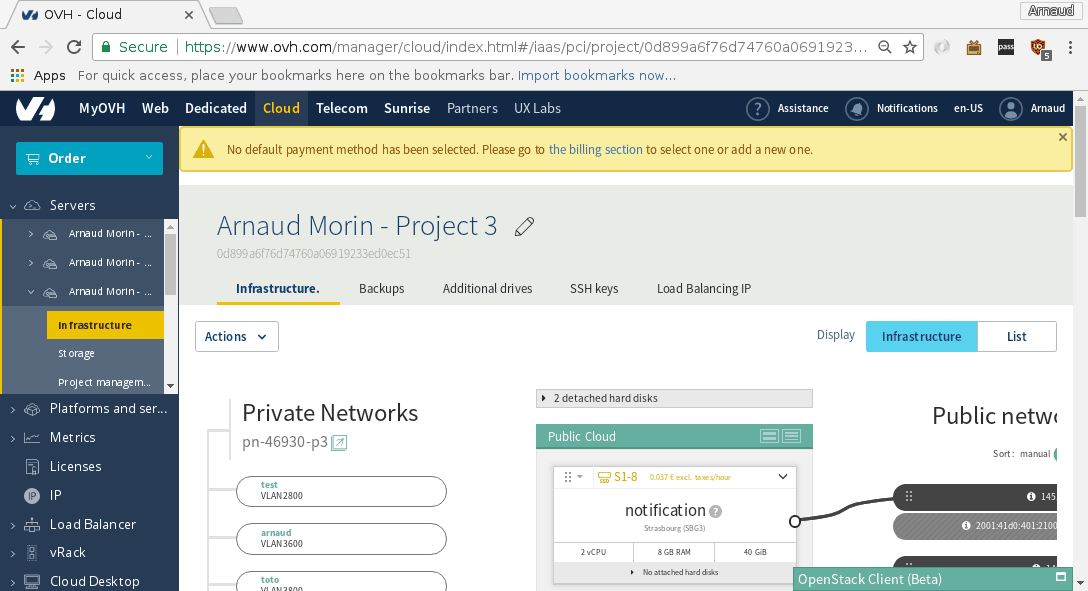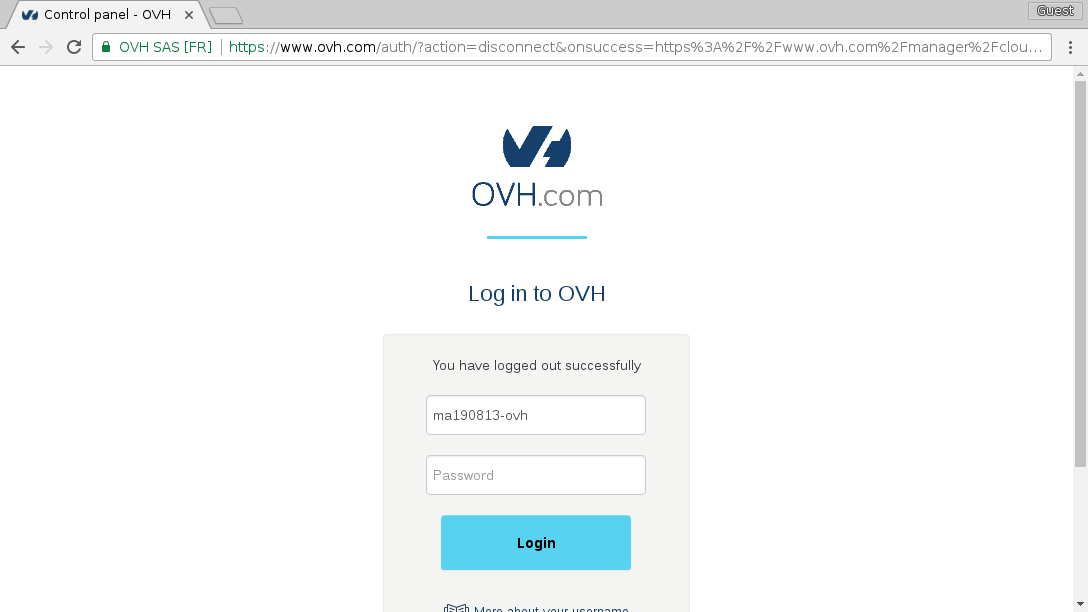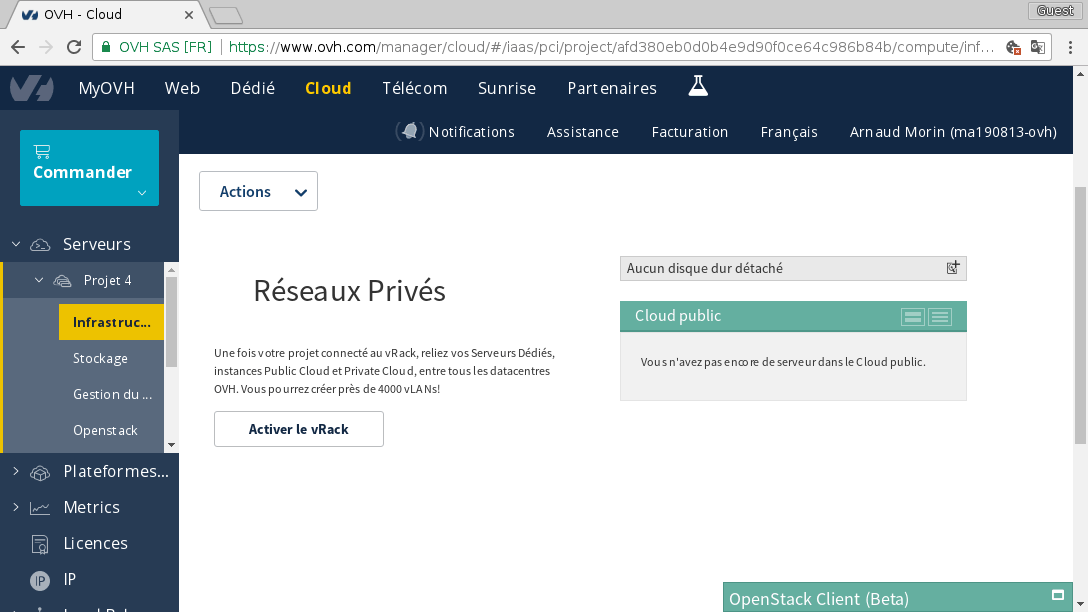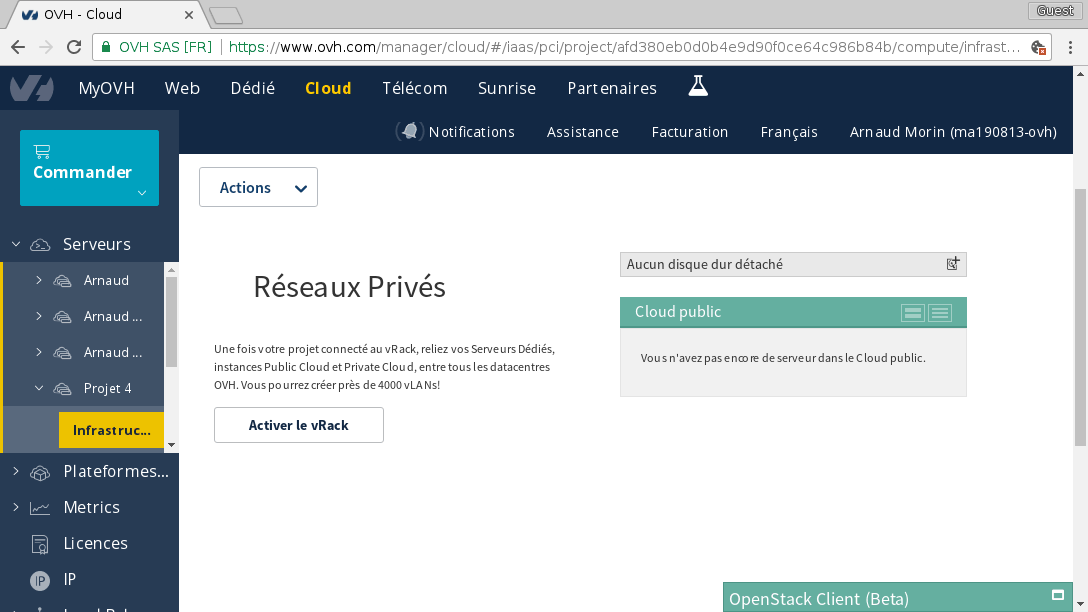Table of Contents
Main objective is to create an small OpenStack infrastructure within an OVH public cloud infrastructure (which is also run by OpenStack by the way :p So we will create an OpenStack over OpenStack).
+------------------+
ssh | |
you +-----------> | deployer |
| |
+------------------+
ansible (ssh)
+------------------+ +------------------+ +------------------+ +-----+
| | | | | | | |
| rabbit | | nova | | neutron | +-----> | |
| | | | | | | v |
+------------------+ +------------------+ +------------------+ | R |
| a | <--------+ Failover IP
+------------------+ +------------------+ +------------------+ | c | xxx.xxx.xxx.xxx/28
| | | | | | | k |
| mysql | | glance | | compute | +-----> | |
| | | | | | | |
+------------------+ +------------------+ +------------------+ +-----+
+------------------+ +------------------+
| | | |
| horizon | | keystone |
| | | |
+------------------+ +------------------+
Every machine will have a public IP and be accessible from internet.
Neutron and compute will also be connected through vRack.
In this vRack we will route a failover IP block (/28 in my example) so that we can give public IPs to instances / routers.
Deployer is used to configure the others (like an admin / jumphost machine).
To start working on this project, you must have:
- an account on OVH
- a cloud project
- a vRack
See here: https://www.ovh.com/fr/support/new_nic.xml
- first register an app on ovh api https://eu.api.ovh.com/createApp/
- then get api token
curl -XPOST -H"X-Ovh-Application: YOUR_APP_KEY" -H "Content-type: application/json" \
https://eu.api.ovh.com/1.0/auth/credential -d '{
"accessRules": [
{ "method": "GET", "path": "/*" },
{ "method": "PUT", "path": "/*" },
{ "method": "POST", "path": "/*" },
{ "method": "DELETE", "path": "/*" }
]
}'
{"validationUrl":"https://eu.api.ovh.com/auth/?credentialToken=Am0xPp...","consumerKey":"YOUR_CONSUMER_KEY","state":"pendingValidation"}- create an
ovhrcfile with api creds from json:
OVH_ENDPOINT="ovh-eu"
OVH_APPLICATION_KEY="YOUR_APP_KEY"
OVH_APPLICATION_SECRET="YOUR_APP_SECRET"
OVH_CONSUMER_KEY="YOUR_CONSUMER_KEY"To do that, you can run the script data/order_ip_block.py
$ python3 order_ip_block.py
Please pay the BC 12345678 --> https://www.ovh.com/cgi-bin/order/displayOrder.cgi?orderId=12345678&orderPassword=ABCD
DoneOnce your BC (Bon de Commande / order) is paid, you should receive a /28 in your manager. You can now move this pool of IP in your vRack by doing so:

$ git clone https://github.com/arnaudmorin/bootstrap-openstack.git
$ cd bootstrap-openstack$ source ovhrcThe terraform script creates an openstack user through the ovh provider, then use its credentials
to setup the openstack provider. Thus we have to apply the terraform script in 3 steps:
$ terraform init
$ terraform apply -var project_id=123ABC...XX99 -var vrack_id=pn-XXXXXX -target ovh_publiccloud_user.openstack
$ terraform apply -var project_id=123ABC...XX99 -var vrack_id=pn-XXXXXX
This will create 8 instances, connected to both public network (Ext-Net) and vRack (public), one for each OpenStack services (see architecture) and one deployer that you will use as jump host / ansible executor.
Once instances are all up and active, terraform will run the ansible playbook on the deployer.
Ansible is using a static inventory file generated by terraform and uploaded through user-data on the deployer instance
in /tmp/inventory
Ansible playbooks are stored in the ./ansible directory and uploaded on the deployer instance in /tmp/ansible through
ssh in a terraform post provisionning action
Terraform applies the playbooks by running the following commands
eval $(ssh-agent) && ssh-add /tmp/ssh-priv-key
export ANSIBLE_HOST_KEY_CHECKING=False
ansible-playbook -e 'ansible_python_interpreter=/usr/bin/python3' -i /tmp/inventory /tmp/ansible/site.ymlAnsible connects to nodes instances by using an ssh keypair generated by terraform, from which the ssh pub key has been uploaded through user-data to all nodes as an authorized_key.
On keystone server, you will find the openrc_admin in /var/lib/keystone and openrc_demo in /home/ubuntu files that can be used to access your brand new OpenStack infrastructure
You can also browse the dashboard by opening url like this: http://your_horizon_ip/horizon/


